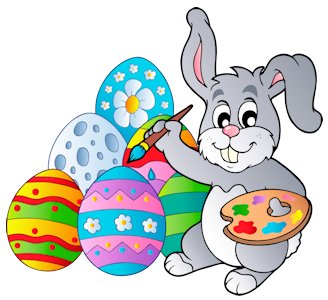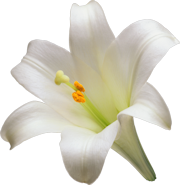

Easter Eggs:

Are used by Christians as the symbol of New Life when,
particularly at this time of the year, we remember how our
redemption was won by the Death and Resurrection of Our
Lord, Jesus Christ.
The shell can be seen as a nurturing, life giving tomb.
The hatching chick represents Jesus emerging from the
tomb. They represent the new life that returns to nature
about Easter time.
The custom of exchanging eggs began in ancient times.
The ancient Egyptians and Persians often dyed eggs in spring
colors and gave them to their friends as gifts.
The Persians ( now Iran) believed that the earth had hatched from
a giant egg.
One ancient tradition was the staining of Easter eggs with
the color red "in memory of the blood of Christ, shed
as at that time of his crucifixion."
Also, of the renewal of life in Spring.
Some people also used the color green, in honor of the
new green foliage emerging after the long winter.
Easter Bunny:

Rabbits usually give birth to a big litter of babies, so
they became a symbol of new life.
Legend has it that the Easter bunny lays, decorates and
hides eggs as they are also a symbol of new life.
The Easter bunny is said to have first arrived in America in the
1700's from German settlers in Pennsylvania along with
their tradition of an egg-laying hare called “Oschter Haws.”
The children believed that if they were good, the "Oschter Haws"
would lay a nest of colored eggs.
Eventually, the custom spread across the U.S. and the fabled
rabbit’s Easter morning deliveries expanded to include chocolate
and other types of candy and gifts, while decorated baskets
replaced nests.
Additionally, children often left out carrots for the bunny in case
he got hungry from all his hopping.
Easter Lilies:

The Easter Lily is the symbol of the resurrection of Jesus.
The white of the Easter Lilies reminds us of the pure new life
that comes to us through the Resurrection
of Jesus.
The White House
Easter Egg Roll:
It has been said that Dolley Madison, wife of President
James Madison 1809 - 1817,
was responsible for the first Egg Roll.
It was not held at the White House but on the grounds of the Capitol.
Not everyone was pleased with this kind of activity and it
was discontinued in 1878.
The old story claimed that this caused unhappy children
carrying their Easter baskets to march to the White House
in protest.
They were invited to use the White House lawn by a sympathetic
President Rutherford B. Hayes and his wife.
The White House Egg Roll is now a tradition.
Adults are admitted to the usually private White House grounds only
if accompanied by a child.
Eggs and candy are hidden for the children to find, and eggs are
rolled down the slight slope of the south
of the Truman balcony.
Other traditions include:
A traditional ham, turkey, or roast dinner.
Parents telling their children that eggs and other treats,
such as chocolate eggs or bunnies, and marshmallow Peeps,
have been delivered by the Easter Bunny in an Easter basket
on Easter morning.
.
.
Never forget the true meaning
of Easter.
'For I delivered to you first of all that which I also received:
that Christ died for our sins according to the Scriptures,
and that He was buried, and that He rose again the
third day according to the Scriptures'
1 Corinthians 15:3 - 4
.

.

.
.

.
